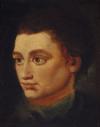Career
Other info : Bibliography
Fergusson's relatively lowly employment gave him liberty to pursue his writing career. There is good evidence he had already been developing literary ambitions as a student at St Andrews where he claimed to have begun drafting a play on the life of William Wallace. His earliest extant poem, also written at this time, is a satirical elegy in Scots on the death of David Gregory, one of the university’s professors of maths.
Fergusson involved himself in Edinburgh's social and artistic circles mixing with musicians, actors, artists and booksellers who were also publishers. His friend, the theatre-manager William Woods, regularly procured him free admission to theatre productions[2] and in mid-1769 Fergusson struck up a friendship with the Italian castrato singer Giusto Fernando Tenducci, who was touring with a production of Artaxerxes. Fergusson's literary debut came when Tenducci asked him to contribute Scots airs for the Edinburgh run of the opera. Fergusson supplied three, which were performed and published with the libretto.
After February 1771 he began to contribute poems to Walter Ruddiman's Weekly Review. These at first were generally conventional English language works that were either satirical or fashionably pastoral in the manner of William Shenstone. His first Scots poem to be published (The Daft Days) appeared on 2 January 1772, and from that date on he submitted works in both languages.
Popular reception for his Scots work, as evidenced in a number of verse epistles in its praise,[3] helped persuade Ruddiman to publish a first general edition of his poems which appeared in early 1773 and sold around 500 copies, allowing Fergusson to clear a profit.[4]
In mid-1773 Fergusson attempted his own publication of Auld Reekie, now regarded as his masterpiece, a vivid verse portrait of his home city intended as the first part of a planned long poem.
It demonstrated his ambition to further extend the range of his Scots
writing. This also included an aspiration to make Scots translations of Virgil's Georgics, thus following in the footsteps of Gavin Douglas.
However, if any drafts for such a project were made, none survive. The
poet was a hard self-critic and is known latterly to have destroyed
manuscripts of his writing.[5]
Fergusson's literary output was both urban and pastoral in equal degree. He was often an effective satirist and generally nationalist in themes and outlook. Although small, his canon stands as an important artistic and linguistic bridge between the generation of Allan Ramsay (1686–1758) and most later writers in Scots. His bilingual career was the acknowledged inspiration for the career of Robert Burns. Many leading makars of the twentieth century, such as Robert Garioch or Sydney Goodsir Smith, similarly recognised his importance. More widely, however, his legacy has tended to be unjustly neglected.
Many works by Burns either echo or are directly modelled on works by Fergusson. For example "Leith Races" unquestionably supplied the model for Burns' "Holy Fair". "On seeing a Butterfly in the Street" has reflections in it which strikingly correspond with "To a Mouse". Comparisons, such as between Fergusson's "The Farmer's Ingle" and Burns' "The Cottar's Saturday Night", often demonstrate the creative complexity of the influence.
Fergusson's life also had one important non-literary influence. The brutal circumstances of the poet's death prompted one of his visitors in Darien House, the young doctor Andrew Duncan (1744–1828), to pioneer better institutional practices for the treatment of mental health problems through the creation of what is today the Royal Edinburgh Hospital.[9]






